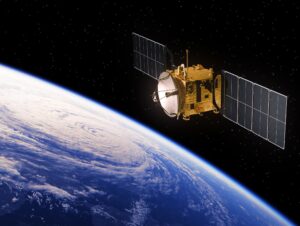Since Nigeria launched its first microsatellite, NigeriaSat-1, in 2003, the country has expanded its space programme and is now a continent-wide leader in the field.
The launch of Sputnik in 1957 signalled the start of a space race that was confined to the superpowers of the time (the United States and the Soviet Union). However, the end of the Cold War in 1991 witnessed more states engaging in space activities.
Nigeria is one of the newcomers in the use of space technology. Since the country is not renowned for scientific and technological prowess, its success in the space domain has surprised the international community and Nigerians themselves. The motivation for developing countries’ space programmes is partly to stimulate national pride and inspire the youth. However, it would be simplistic to restrict Nigeria’s motives to these factors. The country’s embrace of space activities stems from space’s significance in fast-tracking sustainable socio-economic development and guaranteeing national security.
Given the socio-economic challenges confronting Nigeria, including widespread poverty and unemployment as well as the security situation in light of Boko Haram activities in the northern part of the country, this aspiration fits the context.
Nigeria’s ambition to be a significant actor in the space domain can be traced to the Cold War era. In 1976, Abuja declared its space ambitions to the Organisation of African Unity (now the African Union) and the Economic Commission for Africa in Addis Ababa.
However, significant steps were only taken in the late 1980s when the National Council of Ministers approved the establishment of a National Centre for Remote Sensing, and the Ministry of Science and Technology set up the National Committee on Space Applications. The National Agency for Science and Engineering Infrastructure’s (Naseni) establishment of the Directorate of Science in 1993, the setting up of the National Space Research and Development Agency (NASRDA) in 1999 and the Nigerian government’s approval of the National Space Policy in 2001 marked milestones in Nigeria’s space ambition.
Subsequently, Nigeria launched its first earth observation satellite, a microsatellite (NigeriaSat-1) in 2003. The satellite was developed by a UK company and was launched in Plesetsk Cosmodrome (a Russian spaceport in Moscow). It has been used to address socio-economic issues such as land use/land cover, early warning, mapping and monitoring of major roads, erosion, floods and deforestation. The satellite has also provided a platform to share knowledge and address the digital divide in Africa.
NigeriaSat-1 was one of the five satellites of the Disaster Monitoring Constellation (DMC) designed to monitor global natural disasters. In 2005 it was the first satellite to send back images from the east coast of the US in the aftermath of Hurricane Katrina. Similarly, it provided images to aid workers after the 2004 Indian Ocean tsunami.
While Nigeria currently relies heavily on international partners, Abuja understands that this is not sustainable in the long run. Although the goals of building NigeriaSat-2 and NigeriaSat-X by 2011 were achieved, the country was not able to train Nigerian astronauts by 2015. This arguably presents a setback. However, given the resolve to pursue the set agenda, and the country’s remarkable collaboration with some of the major actors in global space activities, Nigeria might achieve these goals whether before, on or after the set dates.
While the minimum life span of the satellite was five years, it was in orbit for more than eight years. NigeriaSat-2 (the first high-resolution satellite with a life span of seven years) was launched in Yasny, Russia in 2011. The primary motivations for launching the satellite include the end of NigeriaSat-1’s lifespan, growing demand for high-resolution images, the level of high-resolution satellite manufacturing technical know-how and efforts to establish local satellite manufacturing capacity.
The goal of developing indigenous satellite manufacturing capability was achieved in 2011 when Nigeria launched the first satellite designed and built by Nigerians, NigeriaSat-X – using a British company, Surrey Satellite Technology Ltd’s (SSTL) facilities – alongside NigeriaSat-2 in Yasny.
In 2007, with China’s assistance, Nigeria launched a communication satellite, NigComSat-1. It aimed to provide reliable telecommunications, broadcasting, broadband services and navigation, and a global positioning system. Among other things, the satellite was designed to enhance e-learning, e-government, e-commerce, tele-education, telemedicine and rural telephony. It has wide coverage including Africa, the Middle East and some parts of Europe, quality service and multicast technology. Unfortunately, the satellite was deorbited in 2008 following failure due to power exhaustion.
Nigeria launched another communication satellite (NigComSat-1R) built in China in 2011. In many respects, it was an improvement on the previous communication satellite, enhancing optimal and cost-effective voice, video, data, internet and application service.
Nigeria’s ambitious space programme is evident in its 25-year road map that was approved by the federal government in 2006. This includes the goal of training Nigerian astronauts by 2015, achieving the technological prowess to manufacture and launch satellites by 2025 and sending an astronaut into space by 2030. The road map reflects the importance the country attaches to relative self-reliance in its space programme.
While Nigeria currently relies heavily on international partners, Abuja understands that this is not sustainable in the long run. Although the goals of building NigeriaSat-2 and NigeriaSat-X by 2011 were achieved, the country was not able to train Nigerian astronauts by 2015. This arguably presents a setback. However, given the resolve to pursue the set agenda, and the country’s remarkable collaboration with some of the major actors in global space activities, Nigeria might achieve these goals whether before, on or after the set dates.
Nigeria has provided leadership in space science and technology in Africa evident in its role in the United Nations Committee on the Peaceful Uses of Outer Space (UNCOPUOS), the African Leadership Conference (ALC) on Space Science and Technology and its support for the establishment of the African Space Agency. Under the auspices of the United Nations, Nigeria hosts the African Regional Centre for Space Science and Technology Education in English Language (ARCSSTE–E) and the Regional Centre for Training in Aerospace Surveys (Rectas) that provide space-based science and technology education for Africans.
It was the first country to contribute its satellite towards the achievement of the objectives of the African Resource Management (ARM) satellite constellation project and the creation of the ALC was proposed by the Nigerian delegation at the UNCOPUOS in 2004.
It is clear that Nigeria has been able to use its clout to enhance the knowledge of other African countries through UN-backed centres and has provided space-based initiatives towards the development of its region. This paints the image of a benign regional power that is concerned about addressing the socio-economic challenges that confront its region. It is perhaps for this reason that South African journalist Simon Allison notes that: “As far as the African space race goes, so far Nigeria is winning.” Daily Maverick, reports.
–
GHM News




